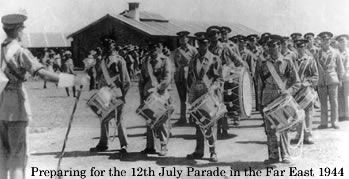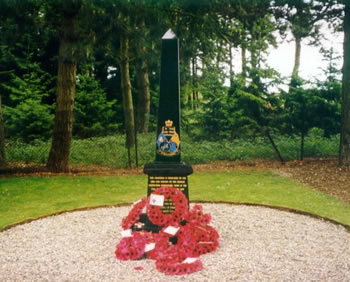Orangeism And The Military
|
Additional reading available from
our on-line shop is shown in yellow
|
"Let
the drums rattle the summons to battle
the
Protestant boys will carry the day".

When the Orange Order was formed in 1795 many
of its early members had seen service in the ranks of the
Volunteer movement.
That early link with the military has been maintained to
the present day and Orangemen and women have worn the uniform
of their country with distinction in all the arenas of war
and peace.
From the 1798 rebellion in Ireland, through the Napoleonic
Wars, to the Two Great Wars, the Falklands and Desert Storm,
Members of the Orange Institution have been in the forefront
of the fight for freedom. Today our Members continue this
tradition being on active service in Northern Ireland, with
the U.N. humanitarian aid force in former Yugoslavia and the
war in Iraq.
Even a casual observer will realise the tremendous part played
by the Orange Institution in keeping the torch of freedom
burning brightly through the sacrifice of its members.
There is however another side to this relationship and it
was largely soldiers who were responsible for the spread of
Orangeism from Ireland across the world.
This relationship has been well documented in official Orange
histories as has the obvious importance of their Orange membership
to the soldiers through the ages.
A few brief examples will illustrate the point.
Whilst most of the stories recounted here refer to World
War I we start with an event from an earlier but equally famous
battle - the Battle of Balaclava.
After the famous charge into "the valley of death"
a British soldier assisting in the removal of the dead and
wounded came across a local plundering the corpse of one of
the soldiers of the Light Brigade. Apprehending the thief
the soldier found that he had taken from the body a piece
of parchment which the soldier, being an Orangeman, recognised
as a Warrant. The dead soldier had been Worshipful Master
of his Lodge and was carrying the Warrant into battle when
he was killed.
From the 1890's various regiments in the British Army had
Lodges operating within the regiment but it was during the
Boer War that we find the first references to soldiers from
various regiments forming a Lodge at the front.
This was of course to become a common occurrence during World
War I when numerous Warrants were issued not only to troops
but also to sailors and most ships in the Royal Navy had Lodges
"on board" at this time.
Indeed the first British naval casualty of World War I was
Able Seaman William George Vincent Williams, a Member of L.O.L.92,
Melbourne, Australia, killed in action on 11th September 1914.
It is estimated that in excess of 200,000 Orangemen from
across the world saw service during the first War some 80,000
from Canada alone. This has been described as Orangeism's
greatest triumph and its heaviest defeat. Triumph in the number
of volunteers who joined the war effort but defeat in that
the Institution lost so many of its young men.
The resolve of those young men may be seen in
the dying words of Bro. Pt. F. Holt, 4th Kings Liverpool Regiment,
(a Member of L.O.L.782) fatally wounded at Neuve Chapelle
on April 14th 1915 who told his comrades "I have done
my duty to my King and Country and I have not forgotten the
Orange obligation I took in 782".
L.O.L.862
after the Battle of the
Somme had decimated their ranks
Many books of the period deal with the Orange spirit found
among the troops and this is reinforced by Bro. Edward McCullough
who on return to his Lodge, Northcote Temperance L.O.L.204,
having been invalided out of the Royal Irish Rifles after
shrapnel wounds advised his Brethren "the heart of every
Orange soldier on active service turns to his Orange Lodge
and the most frequent topic in camp, on the march and for
that matter in aciton itself was Ulster and Orangeism".
One group of Orangemen among the 5th Camerons used what spare
time they had most beneficially in perfecting the Orange Lecture.
The Boyne Anniversary at the front was first celebrated on
12th July 1915. Bro. George Sherwood a native of Belfast serving
with the Canadian Army Service Corps tells the story.
"We (the Canadians) all gathered together with a good
many Ulstermen to celebrate the Battle of the Boyne. The procession
started from "Shrapnel Square" and was headed by
an old scout mounted on a white horse with its mane and tail
plaited with Orange and Purple ribbon. Next came the fife
and drums well decorated with Orange Lilies and "No Surrender"
was painted on the flag we carried".
The 12th has always been celebrated by Orangemen on service
including 1944 in the Far east.
Every opportunity was taken to further the Orange cause and
the military Lodges lost no time in seeking out new candidates.
A report of the December 1915 Meeting of Young Citizens Volunteers
L.O.L.871 meeting in the attic of a bomb damaged house advised
that there was a long list of candidates proposed.
A letter from a Brother written under fire some 500 yards
from the enemy front line to the Secretary of his mother Lodge
in London states "kindly remember me to all the Brothers.
Henry wishes to join our Lodge if God spares him to get back.
I hope to be able to add a few more good members".
A Lodge was even formed in a prisoner of war camp in 1916.
Many Orangemen have been decorated for their bravery and
the first Orangeman to win the Victoria Cross in World War
I was Bro. Private Abraham Acton of Whitehaven who received
his award for "conspicuous" bravery on 21st December
1914 at Rouges Blanc.
The role of the Order in the military would require several
volumes to fully pay tribute to the entire story.
The
Orange Memorial at Thiepval

The idea of a Memorial to our fallen Brethren was first raised
some years ago by Members of No.6 District, Belfast.
The concept received impetus at the time of the Seventy-Fifth
Anniversary of the Battle of the Somme when a number of Brethren
present at the Commemorations in Thiepval formed the opinion
that there was an attempt to remove the Orange presence from
military history and specifically from the 36th Ulster Division.
It was determined that as always truth must prevail and to
ensure that the sacrifice of our Members is ever remembered
a decision was taken to proceed with the Memorial.
The Memorial is dedicated to all those from the Orange Family
worldwide who have given their all for faith and freedom in
numerous conflicts across the world.
It has been sited near Thiepval on the Somme Battlefield
- an area which during World War I saw possibly the finest
example of Orange patriotism and self sacrifice by soldiers
from throughout the Empire.
The Memorial stands 8ft. high and is made from black polished
granite and bears an appropriate motif representing World
Orangeism.
The entire cost of this has been met by voluntary donations
from Brethren and Sisters throughout the World.
The inscription on the Memorial reads:-
This memorial is dedicated to the men
and women of the Orange Institution worldwide, who
at the call of King and Country left all that was
dear to them, endured hardness, faced danger, and
finally passed out of the sight of man by the path
of duty and self sacrifice, giving up their own
lives that others might live in freedom. Let those
who come after see to it that their names be not
forgotten.
|
Back to History Home Page
|

